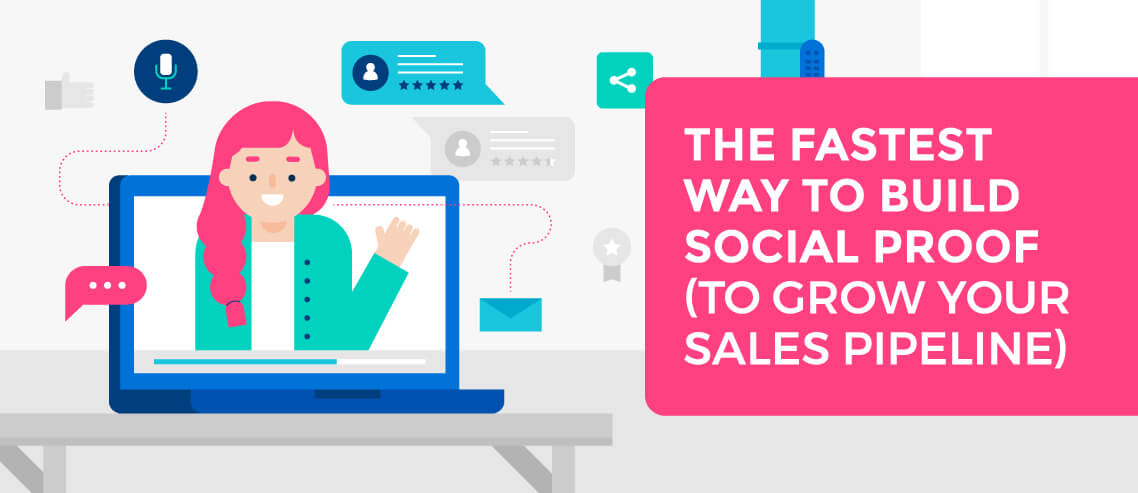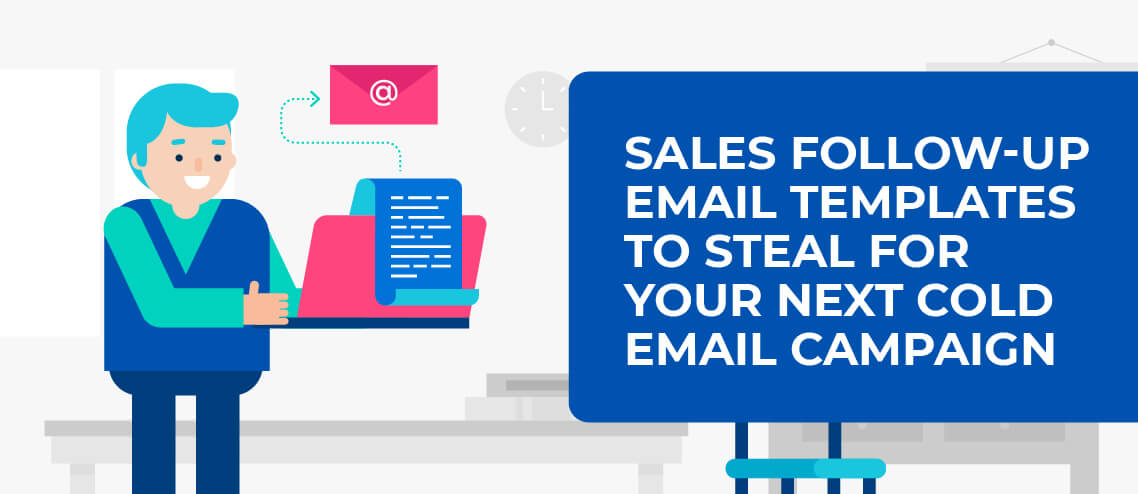The Fastest Way to Build Social Proof (To Grow Your Sales Pipeline)

Contents
When starting any business, your biggest challenge is credibility.
That was the case for my partner and me when we started Blissful Prospecting. It was likely the case for your business too.
The problem is, you’ll lose sales if you aren’t a credible solution to the problem your product/service provides. The better known you are, the easier it is to fill the pipeline and close deals.
I dealt with this first-hand when our business was new. Because prospects hadn’t heard of us, they were skeptical on sales calls. Here are some of the most common objections I ran into:
“How long have you been doing this?” My answer: “We started Blissful Prospecting in 2017, but I’ve been doing outbound since 2013.”
“Do you have any case studies from similar companies?” My answer: “Not yet, but I can show you a few campaigns we’re working on. My cold email worked on you, didn’t it?”
“Have you worked with a client in our industry before?” My answer: “No, but here’s what we’ve done that’s relevant to your business.”
As you can see, I handled the objections and closed sales. But if the prospect was also looking at a competitor with more experience, we lost the sale.
Bottom line, when prospects doubt your credibility, your ability to get results doesn’t matter. The perception is that you’re inexperienced.
From my previous experiences in marketing and sales, I knew that we needed more social proof. We didn’t have the approval from people our target audience already trusted.
So we went on a mission to get interviewed on every sales podcast we could find. To date, we’ve had 30+ appearances on podcasts like Sell or Die! (Jeffrey Gitomer and Jennifer Gluckow), Make it Happen Mondays (John Barrows), The Salesman Podcast (Will Barron), The Sales Evangelist (Donald Kelly), and many more.
And it’s completely changed the dynamic in our sales calls.
Instead of prospects asking me, “How long have you been doing this?” they’re asking questions like, “You’re the expert. What should I do?” Or, “We’re not sure how to get started, how can you help us?”
Now we’re in the driver’s seat (instead of our prospects). And hundreds of prospects are reaching out to us for help — or letting us know how much they enjoyed listening to the interview:




Think about this way…
You have a craving for sushi. There’s a place that’s been in business for 20 years and there’s a new sushi spot down the block that’s been open for a year. Which do you choose? Probably the place that’s been around longer.
But what if the new sushi place had 200 5-star reviews on Yelp? You saw other chefs on YouTube talking highly of them? And there was always a line out the door every time you drove by?
You’d probably reconsider your choice.
And you’re less likely to question the credibility of the new sushi spot.
This is social proof at play.
We’re Wired to Observe Others in Moments of Uncertainty
My wife and I moved to Austin, Texas, a year and a half ago.
Barbeque is very popular in Texas, so we had to try it. Experiencing it for the first time was interesting.
We walk into Rudy’s and I’m feeling a little nervous. I’m uncertain about what to order.
Self-seating is the way most barbeque spots do it. You stand in line for a few minutes (sometimes hours). Then make your order, and they dish it up for you on the spot.
While I’m waiting, I look around to see what everyone else ordered. And when it was our turn to order, I asked the server for his recommendation.
Since I was uncertain about what to do, I made my decision based on what others were doing. It was so instinctual, I didn’t even think about it until after the fact.
This is social proof at play again:
“When a person is in a situation where they are unsure of the correct way to behave, they will often look to others for clues concerning the correct behavior.”
Your prospects are the same way.
We’re naturally skeptical of salespeople. Your prospects have probably had bad experiences with salespeople, or with a service or product didn’t deliver as promised.
When in doubt, they will look at what other people have to say about you…
Your clients.
Your peers.
And what anyone with authority in your industry has to say about you.
Why Podcasts?
I hosted a podcast from 2014 to 2016, so podcasting as a medium to build social proof made sense. Every time someone interviewed me on another podcast, we picked up a client or two and grew our email list.
Podcasts are blowing up right now. There are over 750,000 podcasts, and about a third of the US population listens to podcasts regularly.
Regardless of your niche or industry, there are dozens (potentially hundreds) of podcasts your prospects are listening to.
More reasons why podcasts are great:
The ROI on your time is high. Blog posts like this one take me 5–10 hours to write. Podcasts are usually 30–60 minutes long and take 30–60 minutes of your time to prep for.
Podcasts listeners are very engaged. People typically feel more connected through audio/video than through written words. Many podcasts these days are video and audio. If you’re not a great writer, podcasts are an easier way to connect with an audience.
You can build relationships with the host. Many of my best friendships with people in our industry started with a podcast interview. It’s an easier way to meet than randomly emailing them to grab coffee or hop on a call.
It’s a great way to build your email list. You can create a special giveaway for podcast listeners to grab exclusive content from your website. They give you an email address and you can continue providing value to them.
The challenge, of course, is to get on a podcast.
How to Get on a Podcast
Landing podcast interviews is about selling yourself. Fortunately, you’re already in sales, so it shouldn’t be hard.
Here’s the 5-step process I used to get guest interviews on podcasts to build social proof for our business:
- Step 1: Build a list of qualified podcasts
- Step 2: How to find their email address
- Step 3: Build initial social proof
- Step 4: How to reach out to podcast hosts
- Step 5: How to be a rockstar guest
Now, let’s look at how I did it.
Step 1: Build a list of qualified podcasts
Not all podcasts are created equal. You don’t want to get on a podcast that doesn’t have many listeners or whose listeners aren’t likely to be good prospects.
Make the best use of your time by researching podcasts so you know they’re a good fit. Avoid spending time on a podcast that doesn’t help you accomplish your goals.
To do that, you need to qualify a podcast before reaching out to them.
How to Qualify a Podcast
Per-episode downloads is the top qualifying criteria for any podcast. But that’s hard to find unless the podcast publicly shows its numbers.
Use these criteria:
- Do they have your ideal audience?
- Are they on iTunes?
- Do they have 10 or more reviews? Or at least a 4-star rating?
- Are they consistently releasing new episodes every week?
- Do you like the podcast host?
- Is it an interview-based podcast?
- Do they have a decent-size social presence? (10,000+ followers between their social channels is ideal.)
Where to Find Podcasts
Now the work begins.
iTunes/Podcasts app:
- Search for keywords related to your product/service.
- Hit the related section.
- Pull new keywords from podcasts that are a good fit.
- Make a list of your favorite guests you’ve heard on other podcasts. Search for their name in iTunes to see what podcasts pop up.
- Hit the categories section.
- Find 50–100+ podcasts in your niche.



Google:
Use these search terms:
- “top [insert your niche or area of expertise] podcasts”
- “best [insert your niche or area of expertise] podcasts”
- “top-rated [insert your niche or area of expertise] podcasts”
- “best [insert your niche or area of expertise] podcasts [insert year]”

Podcast directories:
Run the same searches you ran in iTunes on these platforms:
Use a matchmaking site or done for you service:
These services are pretty cool. Look for free tools that can connect you with a podcast host. Check out SpotAGuest.com.
If your time is really strapped, you can also use a booking service. I recommend checking out Jeremy Slate’s company, Command Your Brand.
Step 2: Find their email addresses
Create a spreadsheet for the podcasts that are a good fit for your business. Google Sheets is a good option because it lets you collaborate with VAs, if you need help.
How to find email addresses:
- Check the iTunes listing for the host’s contact information.
- Use a podcast directory like Listen Notes that aggregates the names of the hosts.
- Visit the podcast host’s LinkedIn profile. They might list their email address publicly. If not, use Apollo.io‘s Google Chrome extension to grab their email.
- If all else fails, run a Google search to see if you can find their website and use Apollo.io.
Step 3: Build initial social proof
Before you start emailing, create some content that showcases chops. Podcast hosts love seeing examples before committing to an interview.
The best social proof is other podcast interviews you’ve done. Reach out to people in your network who have a podcast. Ask people in your network if they have anyone to refer you to.
Get a few interviews under your belt before you start your outreach.
You can also create content. It could be a LinkedIn post on a topic you could talk about on their podcast. Or a video showcasing your skills. Videos are great because they can get an idea of how you’d sound in an interview.
Put together 2–3 pieces of high-quality content with decent engagement so you can share it in your outreach.
Step 4: Reach out
This approach IS NOT about using a special email template.
Copying and pasting the emails below won’t work for you. Emulate the framework and make it your own. This has our own flavor to it, along with some inspiration from Jon Buchan over at Charm Offensive.
Mailshake is a great tool to set up and run these email campaigns.
This is what the four email sequence looks like:
- Day 1 – Introductory + social proof email
- Day 4 – Topic ideas
- Day 10 – Quick follow up + something personal/funny
- Day 35 – Last follow up
Overall stats:

We had a 79% open rate and a 42% reply rate!
Now, to get results like this, you need to approach your outreach the right way. To help, I’ve broken down each email below, along with the individual stats at each stage.
? Email #1 – Introductory + social proof
When I sent our first round of emails, we didn’t have much social proof.
Here’s the email that landed the interview on Sell or Die! With Jeffrey Gitomer and Jennifer Gluckow.

Her response:

Here’s why this email worked:
It’s personalized. The subject heading is personalized with her name. And I included a 58-second personalized video (watch here).
There’s social proof. It’s easy to see that others have interviewed me on similar topics.
Clear CTA. The email ends with a casual question. I was careful not to ask, “When can we schedule an interview?” Be clear with your ask, but don’t be too assumptive.
It’s about them. I don’t talk about how great I am in the email. I compliment their podcast and give them ideas on what would be valuable for their audience. My goal is to make THEM look better.
Here’s how the email changed over time as I landed more podcast interviews:

? Email #2 – Topic ideas (3 days later)

Finding great guests is a big challenge for podcasters. So is researching them to come up with topics to talk about.
Make it easy for the host to say “yes” to you.
Email #1 focused on social proof. Email #2 focuses on providing topic ideas:

Notice the email leads with empathy. Acknowledge they probably get hit up a lot to get on their show.
The second key part is the topic list. Focus on sticky topics their audience really wants to hear about. And link to those posts.
Here are the links from the email above if you want to check them out:
? Email #3 – Quick follow up + something personal/funny (10 days later)

Email #3 is about showing persistence. Don’t be afraid to showcase a little bit of your personality as well.

That’s right, I’m pulling the “I have a cute puppy card.”
? Email #4 – Last follow up (15 days later)

This is the last email in your sequence and has one more call to action. Nothing too special here. There’s a call back to our puppy, Pepe, and one more call to action to chat about the podcast feature.

Should You Use A Personalized Video?
Video will significantly increase your response rates. I highly suggest using a tool like Vidyard to embed videos in your emails.
If you listen to the podcasts we’ve done, many of the hosts mention the video I sent them.

Check out our video prospecting guide to learn how to use video in your cold outreach.
Step 5: Be a rockstar guest (It’s easier than you think!)
Most podcast hosts prepare very little for their interviews. In my experience, most spend 10–15 minutes looking at your website and LinkedIn profile.
Take it upon yourself to prepare:
Invest in a microphone. It makes a huge difference in quality and many podcasts require it. The Blue Yeti USB mic is what many people use. If you’re looking for a mic that’s more budget-friendly, check out the Logitech H390.
Listen to a full episode of their show. Get a good feel for the structure and types of questions they ask.
Research the host. Visit their LinkedIn profile and website. You should feel like you already know them before you hop on the interview. Use what you learned as conversation starters when you hop on the podcast.
Prepare 2–3 topics. Know your talking points beforehand. Listeners need to hear you showcase your chops. If you have a unique framework or process, share it (like we do with the REPLY Method).
Create a landing page with a free download (see example below). I talk about the REPLY Method on podcasts. We discuss it in-depth in the interview and call back to a one-page guide they can download.

There’s usually a 5-15 minute warm-up period when you hop on the call before the interview starts. Use these questions to tailor your content:
- “Who is your audience?”
- “Are they more executers in tactical roles? Or are they in leadership roles?”
- “What size/stage are their businesses?”
- “Are they in particular industries?”
- “Is there anything you want to make sure I cover today that would be valuable for your audience?”
- “Anything else you can tell me about what your listeners really respond well to?”
Now It’s Your Turn
To build credibility that keeps your pipeline full, nothing beats podcasts. And now, you know how to get on a podcast, including the tools and process to land interviews on top podcasts in your industry.
Here’s your next steps:
- Identify 50–100 good fit podcasts.
- Find the host’s email addresses using Apollo.io.
- Build initial social proof by creating 2–3 pieces of content showcasing your chops.
- Send a personalized 4-email sequence using Mailshake (bonus points if you use Vidyard to send a personalized video).
- Be a rockstar guest by preparing topics for the interview and having a free giveaway for the audience.





